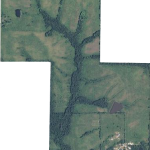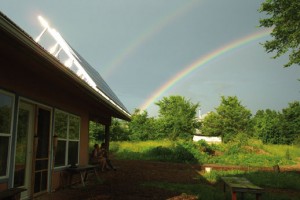Our Land

 Our land includes six ponds and a small creek that runs much of the year. We have 40 acres in woodland plus 30 acres where we have planted over 12,000 trees as part of our restoration efforts. We’ve also established about 20 acres of native prairie grasses and are working to reintroduce other native grassland species. Our savanna ecosystem (a combination of trees and grasslands) means we’ve got a diversity of ecological niches for a diversity of species.
Our land includes six ponds and a small creek that runs much of the year. We have 40 acres in woodland plus 30 acres where we have planted over 12,000 trees as part of our restoration efforts. We’ve also established about 20 acres of native prairie grasses and are working to reintroduce other native grassland species. Our savanna ecosystem (a combination of trees and grasslands) means we’ve got a diversity of ecological niches for a diversity of species.

Village Design and Planning
Permaculture and Patterns
Dancing Rabbit has the exciting and daunting task of designing and building a village with sustainability as a key focus. While our village is still small, we are growing steadily towards our target population of 500-1000, which keeps our Land Use Planning committee very busy.
Our overarching goal is to design a resource-minimizing and community-promoting, pedestrian-scaled village that minimizes our footprint on our land to leave space for agriculture and wildlife habitat.
Our design has been influenced both by permaculture principles and Christopher Alexander’s A Pattern Language. We are creating a village with small homes and productive yards including gardens, fruit trees, and social spaces. We strive to cluster buildings to increase density and create positive social and ecological interactions between them (eg courtyards, shared infrastructure, etc.)
We encourage passive solar design while also working with the lay of our land and the existing vegetation. It can be challenging to optimize each building for passive solar while still creating a densely clustered village where buildings interact positively.
An ongoing challenge in our design is the tension between overarching design and organic growth. We need to have a plan for the future that holds our values and vision, while also meeting the needs of the current community members. It can be tricky at times to plug each individual’s or family’s vision into the village plan and still promote the long term patterns for growth we are hoping for.
Our current designs show that we might need more land to meet our population goals, but we have time before that need will be urgent. We’ve currently sketched out space for up to 300 people including homes and businesses, as well as gardens and green spaces.
The Area Around Dancing Rabbit
Surrounding Area
Dancing Rabbit is located in the northeast corner of Missouri, 1 mile north of the small town of Rutledge. The surrounding area is primarily agricultural, with mostly small farms with an aging populace. Mennonites have also been making this area their home since the mid seventies and are a growing portion of the population. Need directions to get here?Other Communities
Our area is home to three other intentional communities which makes for a vibrant and diverse community culture. You can read more about each of them on our Local Communities page.Rutledge
Rutledge was founded in the late 1800s when the railroad first came through this area of Missouri (unfortunately Amtrak does not stop here—yet!). At that time there was actually a small town at Sandhill, 2.5 miles away, which disappeared when the railroad went through Rutledge. Rutledge now boasts a population just over 100 with a gas station, two fix-it shops, a car wash, post office, and Zimmerman’s. Zimmerman’s is a Mennonite-run grocery store famous in this area for its low prices, especially on bulk and health foods, including organics, medicinal herbs, and even vegan desserts. Rutledge is also home to the world-famous Dog and Gun Auction/Flea Market, a multi-acre flea market that takes place once a month near town and brings thousands of people in from hundreds of miles around.Scotland County
Dancing Rabbit is at the southern edge of Scotland County which has a population of about 5000 and is primarily agricultural with most farmers growing corn or soybeans, or raising cattle. People here are generally friendly and open to what we are doing (Sandhill Farm has had good public relations since 1974). And they are open to such things as organic farming and alternative energy. We have really enjoyed making friends with our neighbors and learning about country living.Memphis
Memphis, 13 miles north of Dancing Rabbit, is the county seat and is home to half the population of the county. It has the classic midwestern town layout with the courthouse on the central square. Since Memphis is far enough from larger towns nearby, it still acts as the economic catch basin for the entire county. In Memphis, most of the stores on the square are open and thriving with very few national chains and provide most of the services one might need: a movie theater, a library, hardware stores, a hospital, schools, and even a summer musical. We have a running column in the local paper, The Memphis Democrat, which lets local folks know whats up at DR.Kirksville
Dancing Rabbit is about 35 miles from Kirksville, MO (pop 25,000) which is the home of Truman State University and the Kirksville College of Osteopathic Medicine. Here one can find many of the familiar surroundings of a college town: lots of young folks, progressive politics, a University Library, coffee shops, etc. Truman State even brings in such cultural events as the St. Louis Symphony, the opera, and the ballet. We’ve had a number of college classes come out to see our community scene and have made some great connections with students there. We even got a spot on the local TV news once.Northeast Missouri
There is more progressive culture in the midwest than most people think and it’s exciting to find that many little pockets of it surround us in northeast Missouri (aka NEMO). We are about 50 miles from Quincy, IL, 60 miles from Ottumwa, IA, 60 miles from Fairfield, IA (an incredibly hip little town), 100 miles from Columbia, MO (home of the University of Missouri, also known as Mizzou), 200 miles from St. Louis, MO, 180 miles from Kansas City, MO and about 300 miles from Chicago, IL.Our Weather
For one thing, it’s a lot easier to describe the climate than the weather, since the latter can change on an hourly basis.

In any case, we’ve got a great four-season climate. In the winter, we ice skate on the pond and get enough snow to go cross-country skiing. As things turn warmer we tap our maple trees and make maple syrup. Then spring arrives and all is green and warm, though springs can also be wet and muddy. Although summers can be dry, we generally have enough rain to keep spring’s garden alive with only minimal watering. Sometimes the summer storms also bring us a rainbow or two.
Humidity and mosquitoes can take their toll, but the long sultry evenings and gorgeous sunsets over the hills make it all worth it (not to mention a dip in the pond). A crisp fall welcomes in apple picking and the sorghum harvest at Sandhill. Finally, the leaves drop off the trees and it’s winter again.
You can get just about any kind of weather in Missouri—blistering hot summer days and frigid winter ones. On the other hand, it never stays at either extreme very long.
